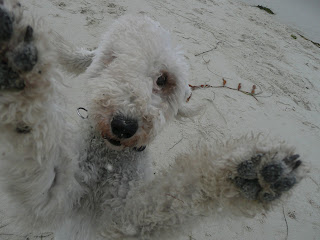“This is a very engaging dog,” said my brother-in-law. “I’m not a dog person,” he added, smiling, “but this is a very engaging dog.”
Over the last couple of weeks, Cleo has been learning that one size does not fit all. Although her default mode of greeting is still to hop repeatedly on her back feet, reaching her front paws to the greetee’s thighs while simultaneously trying to clasp the person’s hand in her mouth, it has clearly begun to dawn on her that not everyone finds such behavior charming. She has long known that her mom, her dad and her trainer, Pluis, aren't amused. The kids at school, on the other hand (probably a hand sodden with puppy spit), can be counted on to let her get away with it. But I have a top secret plan to deal with this behavior!
Still, Cleo has shown lately that she understands that individuals must be treated, well, individually. My little girl, now just weeks away from her first birthday, is growing up.
Puppy's Log: Fall 2011
Marvin the cat must be given a wide berth if you want to avoid getting your nose smacked, but if you keep a foot between you and him, you can bounce in front of him, barking in his face because he’s too stout to close the distance between the two of you before you dodge away.
Rufus the cat will not only tolerate being chased, but will sometimes wait for you to catch up to him. He is a pacifist and won’t claw you even when you wake him up by jumping onto the chaise and socking him in the ribs. It’s cozy to curl up back to back with him for a nap.
Daddy likes to roughhouse and will do exciting things like turning you upside down, but it’s okay because he will never let you get hurt. You can be wild with him. He is best at playing keep-away and you can hang onto the ball because he will chase you all over the house until you drop it by accident. But when he whispers, “Leave it,” then you should because he will do something fun with it, like throw it really far. Daddy doesn’t like it when you lie all over him because it makes him claustrophobic.
Mommy loves it when you lie all over her. It is best when she helps you onto the bed in the morning so you can curl up together. Then you can shove your back into her chest and curl up into a tight little ball and she will spoon you. You need to do what she says even when you don’t want to because when you do she pats you and kisses your head and tells you how smart you are. She is not as fast as Daddy at keep-away, but she will keep playing with you if you shove the ball against her leg when her back is turned.
You can play really rough with the blonde girl at school because it makes her giggle and roll around with you. You can hold her arm in your mouth and lick her nose and push on her shoulders with your paws outstretched. She misses you a lot when you are gone and tells Mommy she’s sad that you’re not there.
The brown haired girl likes it better when you try to outsmart her in keep-away. You can’t play rough with her, but she will make obstacle courses for you for hours and hours. She doesn’t laugh or giggle, but she smiles and whispers to you a lot. It’s best if you stand and listen to her. If you stand on your back feet and very gently put your front paws on her leg she will pat you.
If people at the beach are walking hand in hand, you can run between them and they will admire you. If they are walking close together, but not holding hands, you can put your sandy paws on their legs and they will laugh and talk to Mommy and Daddy about you. If they are walking alone or sitting by themselves, you need to go up to them and touch them with your nose. Then they will pat you and they might smile at you, too. With that tiny old woman who you passed yesterday as she tottered onto the beach, you have to go back to her and very gently stand at her feet so that she can slowly reach down to pat you. You have to smile at her and then politely step away a few feet before you bound across the sand back to Mom.
If you reach up to hug Aunt Laurel, she will take your picture. Don’t try to chew on her because she will hold your mouth closed and explain why chewing on people is a bad idea. She has long hair that sweeps down around her shoulder when she bends to pat you. It is very interesting to look at. If you hold the ball in your mouth and stare at her, she will chase you. If you give her the ball, she’ll bounce it for you.
 |
| Photo by Aunt Laurel |
Uncle Milton is trickier. He will try to avoid you altogether. He will step away from you if you get too close and he really doesn’t like it if you jump up on him. You have to try all kinds of things to get him to pay attention. But if you wait till he’s sitting down, you can take the ball to him and very, very gently put your paws on his leg. You can look him in the eye. Then, when he reaches for the ball you can dance away and he will smile at you. If you put the ball at his feet, he will play soccer with you. Eventually, he will laugh and call you “a very engaging dog.”








